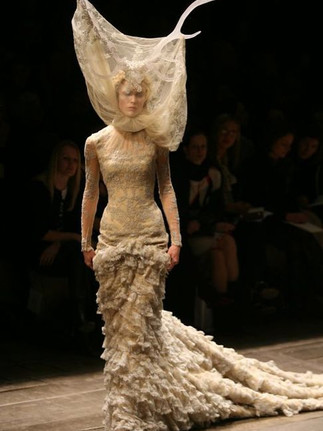Style Deep Dive: Fairycore
- Celine Hijazi

- Feb 26, 2024
- 3 min read
Updated: Oct 23, 2025
By Celine Hijazi

The most recent (and surprising) grammar trend to sweep online is calling something “something-core.” In essence, “core” encapsulates the essence or aesthetic of something. Where is this trend most applicable? The fashion world. From the coziness of cottagecore to the harshness of grunge core, people in the fashion industry have a new catch-all term to describe the previously indescribable and niche trends.
In particular, the new term “‘fairycore”’ has been dominating the online world. Fairycore is intrinsically linked to nature: it uses the aesthetic of a fairy and attempts to incorporate it into everyday life. This isn’t something as direct as dressing like Tinkerbell, but maybe trying to incorporate that aesthetic into your daily wardrobe via color palette or textures.
What does this look like? The most defining aspect of fairycore is softness. From a pastel color palette to a heavy reliance on materials like silk or lace, fairycore is an extremely delicate and dainty way to dress. On the cosmetic side, hairstyles are messy and effortless, and makeup is typically natural and dewy. However, the innate whimsy of fairycore makes it easy to editorialize for shoots and events.
Lots of stylists have tried to incorporate the aesthetic and elevate it to high fashion sensibilities. For example, in her Spring/Summer 2024 show, Susan Fang created looks that heavily relied on thin lace and pastels to try to emulate the surrealism of fairy core (with some looks even directly including wings). Moreover, many of the designs from this collection borrowed textures from the natural world as fairycore tends to do.
Despite the recent virality around fairycore, however, the trend being popularized can be seen from at least 20 years ago. Most notably, with the 2006 Alexander McQueen show, "The Widows of Culloden." The show was extremely gothic with a light twist - with long draping white gowns used to create an otherworldly effect. Although the style is very historical, the way McQueen created this Victorian effect by utilizing natural elements, light natural makeup, and updos that incorporate flowers and butterflies.
Other than high fashion, fairycore has especially high popularity because of how easily accessible it is. It’s a style that - in most ways - focuses on minimalism. Therefore, it is easy to reproduce for any audience. From dainty jewelry to minimal emphasis on makeup, fairycore is about embracing what is natural and elevating it through layering diverse yet independently simple pieces. Thus, the style is easy to thrift and even recreate.
Unlike other popular clothing styles that gain traction through social media, fairycore doesn't put emphasis on purchasing from one store or another. While earthy stores like Free People and Anthropologie are great places to turn for fairycore staples, there is no set group of stores that wearers of fairycore extoll. The style is deeply individualistic and focused on styling creatively, as opposed to owning a few common pieces that define the style.
In contrast to other styles present in the social sphere, fairycore differentiates itself by being simplistic, ethereal, and elegant. It has been around since the conception of a fairy and continues to evolve generationally.


This article was written by Celine Hijazi with additions by Erica Schwartz. Photo credit to Abby Carella. Styling by Payton Breck and Abby Carella. Creative direction by Molly Newell, Julie Wang, and Sarah Gazitt. Jewelry, wings, and corset by Cecilia Muniz (High on Silver). Hair and makeup by Sarah Gazitt and Cecilia Muniz. Thank you to models Valeria Castillo, Sarah Gazitt, and Nahomi Brea Rivera. You can view the rest of the shoot here.

















































Comments